Computer Concepts in Action ©2009Unit 4:
Word ProcessingCreate and Format TablesCreate and Format Tables – Part 1 Create Tables Using Different Options
Tables are a great way to organize information so it is both useful and visually appealing. Microsoft Word offers a variety of ways to quickly and easily create tables in order to help you better organize your information.
To open the data file in Step 2, click on the link. If you are not able to download the file, ask your teacher for help. - Start Microsoft Word.
- Open your Digital Music document. (Note: If you have not created a Digital Music file in previous activities, use the
 Digital Music
(9.0K)
data file and save it as Your Name Digital Music.) Digital Music
(9.0K)
data file and save it as Your Name Digital Music.)
- Click the Insert tab on the Ribbon, and click the Table button.
- Click Draw Table in the Table menu. The mouse pointer changes to a pencil.
- Position the pencil under the M in Music File Types, click and drag the box to the right and down (Figure 1).
Figure 1 Draw a table.
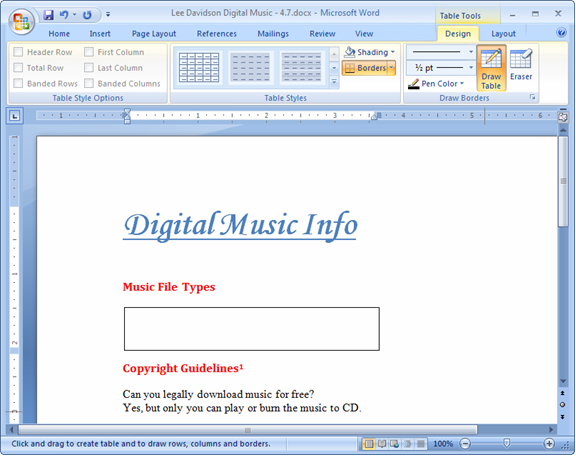 <a onClick="window.open('/olcweb/cgi/pluginpop.cgi?it=jpg::::/sites/dl/free/0078805775/595818/Enrichment_Activity_4_8_U04_SC01.jpg','popWin', 'width=NaN,height=NaN,resizable,scrollbars');" href="#"><img valign="absmiddle" height="16" width="16" border="0" src="/olcweb/styles/shared/linkicons/image.gif"> (164.0K)</a> <a onClick="window.open('/olcweb/cgi/pluginpop.cgi?it=jpg::::/sites/dl/free/0078805775/595818/Enrichment_Activity_4_8_U04_SC01.jpg','popWin', 'width=NaN,height=NaN,resizable,scrollbars');" href="#"><img valign="absmiddle" height="16" width="16" border="0" src="/olcweb/styles/shared/linkicons/image.gif"> (164.0K)</a>- Inside the box, draw one vertical and one horizontal line.
- Click the Table Tools Layout tab, and click the Distribute Rows and Distribute Columns buttons.
- Refer to Figure 2 to key text in the table.
Figure 2 Enter the information.
 <a onClick="window.open('/olcweb/cgi/pluginpop.cgi?it=jpg::::/sites/dl/free/0078805775/595818/Enrichment_Activity_4_8_U04_SC02.jpg','popWin', 'width=NaN,height=NaN,resizable,scrollbars');" href="#"><img valign="absmiddle" height="16" width="16" border="0" src="/olcweb/styles/shared/linkicons/image.gif"> (172.0K)</a> <a onClick="window.open('/olcweb/cgi/pluginpop.cgi?it=jpg::::/sites/dl/free/0078805775/595818/Enrichment_Activity_4_8_U04_SC02.jpg','popWin', 'width=NaN,height=NaN,resizable,scrollbars');" href="#"><img valign="absmiddle" height="16" width="16" border="0" src="/olcweb/styles/shared/linkicons/image.gif"> (172.0K)</a>- Select all of the text under Copyright Guidelines.
- Click the Insert tab, and click the Table button. Click Convert Text to Table.
- In the Convert Text to Table dialog box, key the number 2 in the Number of columns field. Click OK.
- Click anywhere in the document to deselect the text. A new table is created using the selected text (see Figure 3).
Figure 3 Convert text to a table.
 <a onClick="window.open('/olcweb/cgi/pluginpop.cgi?it=jpg::::/sites/dl/free/0078805775/595818/Enrichment_Activity_4_8_U04_SC03.jpg','popWin', 'width=NaN,height=NaN,resizable,scrollbars');" href="#"><img valign="absmiddle" height="16" width="16" border="0" src="/olcweb/styles/shared/linkicons/image.gif"> (200.0K)</a> <a onClick="window.open('/olcweb/cgi/pluginpop.cgi?it=jpg::::/sites/dl/free/0078805775/595818/Enrichment_Activity_4_8_U04_SC03.jpg','popWin', 'width=NaN,height=NaN,resizable,scrollbars');" href="#"><img valign="absmiddle" height="16" width="16" border="0" src="/olcweb/styles/shared/linkicons/image.gif"> (200.0K)</a>- Select your new Copyright Guidelines table.
- Click the Table Tools Layout tab, and locate the Data group. Click the Convert to Text button.
- In the Convert Table to Text box, select Paragraph Marks and click OK. Your table has been converted back to text.
- Click the Undo button to restore your table.
Create and Format Tables – Part 2
Work with Columns and Rows
Once it has been created, it is easy to modify the table structure. You can add or delete rows and columns, or change the way they are formatted. - Move the insertion point to the end of the word Wave in the first table.
- Click the Table Tools Layout tab, and click the Insert Below button. A new row is added to the table.
- Repeat Step 2.
- In the new third row, key MP3 in the first column and Compressed audio file in the second column.
- Position the insertion point in the cell underneath MP3. Click the Table Tools Layout tab if necessary, and click the Split Cells button.
- Click OK in the Split Cells box. The cell is split into two cells (Figure 4).
Figure 4 Split the cells in a table.
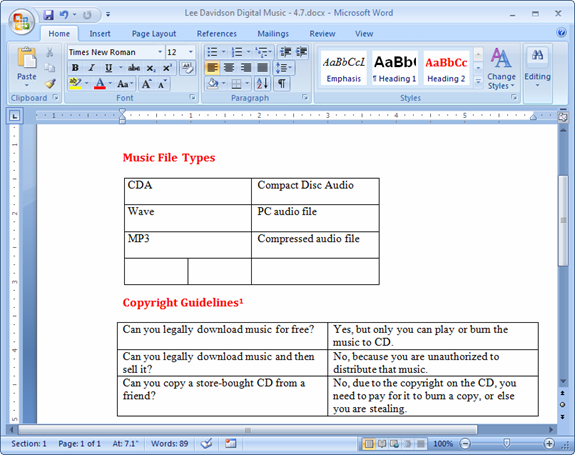 <a onClick="window.open('/olcweb/cgi/pluginpop.cgi?it=jpg::::/sites/dl/free/0078805775/595818/Enrichment_Activity_4_8_U04_SC04.jpg','popWin', 'width=NaN,height=NaN,resizable,scrollbars');" href="#"><img valign="absmiddle" height="16" width="16" border="0" src="/olcweb/styles/shared/linkicons/image.gif"> (206.0K)</a> <a onClick="window.open('/olcweb/cgi/pluginpop.cgi?it=jpg::::/sites/dl/free/0078805775/595818/Enrichment_Activity_4_8_U04_SC04.jpg','popWin', 'width=NaN,height=NaN,resizable,scrollbars');" href="#"><img valign="absmiddle" height="16" width="16" border="0" src="/olcweb/styles/shared/linkicons/image.gif"> (206.0K)</a>- Verify that the insertion point is in the last row of the first table, and click the TableToolsLayout tab if necessary. Click the Delete button, and click Delete Rows.
- Position the insertion point before MP3. Locate the Merge group on the Table Tools Layout tab, and click Split Table. The table is split.
- Press the Delete key. The table is automatically joined again.
- Position the insertion point in the cell Compact Disc Audio. Click the Table Tools Layout tab, and click the Insert Right button. A new column appears.
- Select the empty cell in the lower right hand corner of the table. Click the Table Tools Layout tab, click the Delete button, and click Delete Cells.
- In the Delete Cells box, select Shift cells left and click OK. The cell disappears.
- Position the insertion point where there is now no cell (outside of the table, next to “Compressed audio file”). Click the Table Tools Layout tab, and click the Table Insert Cells Dialog Box Launcher.
- In the Insert Cells box, select Shift cells right and click OK. A new cell appears.
- Select the three cells in the empty column. Right-click on the highlighted column and choose Delete Columns. The column disappears.
- Select the first column in the Music File Types table.
- Click the Table Tools Layout tab, and click the Properties button. The Table Properties dialog box displays. Click the Column tab in the dialog box.
- In the Preferred width field, key the number 4, and then click OK. The first column is now 4 inches wide.
- Select the first column, if necessary. Click the Table Tools Layout tab, and click the Properties button. Click the Row tab.
- In the Specify height field, key the number 1.
- In the Row height is field, use the arrow to choose Exactly.
- Click OK. Your table should look like the one in Figure 5.
Figure 5 Change the height and width of the first column.
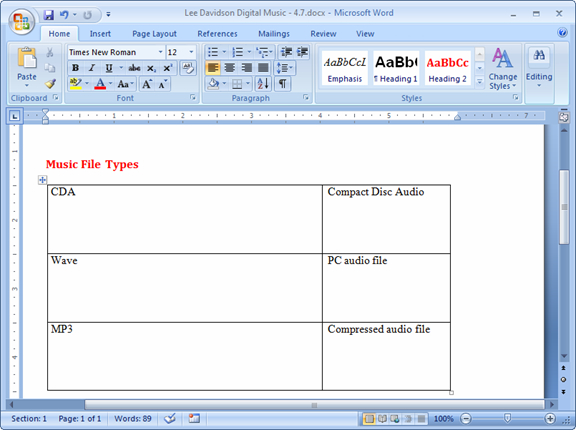 <a onClick="window.open('/olcweb/cgi/pluginpop.cgi?it=jpg::::/sites/dl/free/0078805775/595818/Enrichment_Activity_4_8_U04_SC05.jpg','popWin', 'width=NaN,height=NaN,resizable,scrollbars');" href="#"><img valign="absmiddle" height="16" width="16" border="0" src="/olcweb/styles/shared/linkicons/image.gif"> (144.0K)</a> <a onClick="window.open('/olcweb/cgi/pluginpop.cgi?it=jpg::::/sites/dl/free/0078805775/595818/Enrichment_Activity_4_8_U04_SC05.jpg','popWin', 'width=NaN,height=NaN,resizable,scrollbars');" href="#"><img valign="absmiddle" height="16" width="16" border="0" src="/olcweb/styles/shared/linkicons/image.gif"> (144.0K)</a>- Click the Table Tools Layout tab, and click the Properties button.
- Click the Row tab, and change Specify height to 0 and Row height is to At least.
- Click the Column tab. In the Preferred width field, key the number 0.
- Click OK. The cells adjust to fit the tallest and widest entries (Figure 6).
Figure 6 The table fits the content.
 <a onClick="window.open('/olcweb/cgi/pluginpop.cgi?it=jpg::::/sites/dl/free/0078805775/595818/Enrichment_Activity_4_8_U04_SC06.jpg','popWin', 'width=NaN,height=NaN,resizable,scrollbars');" href="#"><img valign="absmiddle" height="16" width="16" border="0" src="/olcweb/styles/shared/linkicons/image.gif"> (203.0K)</a> <a onClick="window.open('/olcweb/cgi/pluginpop.cgi?it=jpg::::/sites/dl/free/0078805775/595818/Enrichment_Activity_4_8_U04_SC06.jpg','popWin', 'width=NaN,height=NaN,resizable,scrollbars');" href="#"><img valign="absmiddle" height="16" width="16" border="0" src="/olcweb/styles/shared/linkicons/image.gif"> (203.0K)</a>- Save your file.
Create and Format Tables – Part 3
Use Table Styles
Word offers you the ability to automatically format your table using a variety of standard table styles. In this exercise you will use the Table Styles and AutoFit functions to add some variety to your Digital Music file.
- In your Digital Music file, select the Music File Types table.
- Click the Table Tools Design tab.
- Locate the Table Styles group, and click the More button to display the gallery of table styles.
- Point to several of the thumbnail table styles, and click the second style in the third row of the Built-in styles (Table Contemporary).
Figure 7 The Table Styles gallery
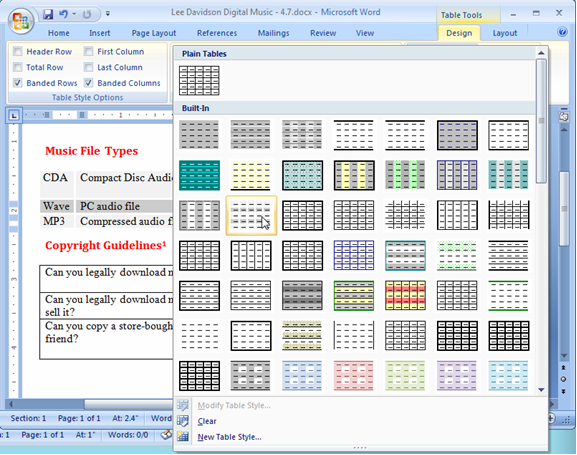 <a onClick="window.open('/olcweb/cgi/pluginpop.cgi?it=jpg::::/sites/dl/free/0078805775/595818/Enrichment_Activity_4_8_U04_SC07.jpg','popWin', 'width=NaN,height=NaN,resizable,scrollbars');" href="#"><img valign="absmiddle" height="16" width="16" border="0" src="/olcweb/styles/shared/linkicons/image.gif"> (241.0K)</a> <a onClick="window.open('/olcweb/cgi/pluginpop.cgi?it=jpg::::/sites/dl/free/0078805775/595818/Enrichment_Activity_4_8_U04_SC07.jpg','popWin', 'width=NaN,height=NaN,resizable,scrollbars');" href="#"><img valign="absmiddle" height="16" width="16" border="0" src="/olcweb/styles/shared/linkicons/image.gif"> (241.0K)</a>- Select the Copyright Guidelines table, and click the Table Tools Design tab on the Ribbon. Click the More button in the Table Styles group.
- Click Table 3D effects 2 in the first row of the Built-in styles. Locate the Table Style Options group, and uncheck Header Row.
- Deselect the table. Your tables should look like Figure 8.
- Close the Tables and Borders toolbar. Deselect the table. Your tables should look like Figure 8.
Figure 8 The completed tables
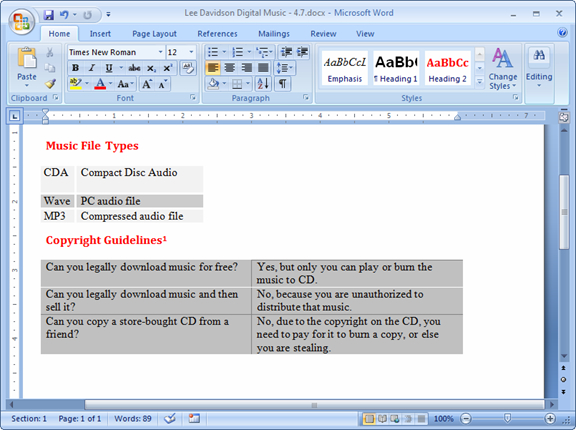 <a onClick="window.open('/olcweb/cgi/pluginpop.cgi?it=jpg::::/sites/dl/free/0078805775/595818/Enrichment_Activity_4_8_U04_SC08.jpg','popWin', 'width=NaN,height=NaN,resizable,scrollbars');" href="#"><img valign="absmiddle" height="16" width="16" border="0" src="/olcweb/styles/shared/linkicons/image.gif"> (200.0K)</a> <a onClick="window.open('/olcweb/cgi/pluginpop.cgi?it=jpg::::/sites/dl/free/0078805775/595818/Enrichment_Activity_4_8_U04_SC08.jpg','popWin', 'width=NaN,height=NaN,resizable,scrollbars');" href="#"><img valign="absmiddle" height="16" width="16" border="0" src="/olcweb/styles/shared/linkicons/image.gif"> (200.0K)</a>- Save your file.
- Exit Microsoft Word.
 |  |

























